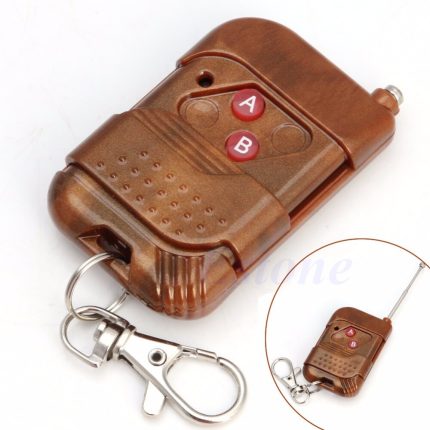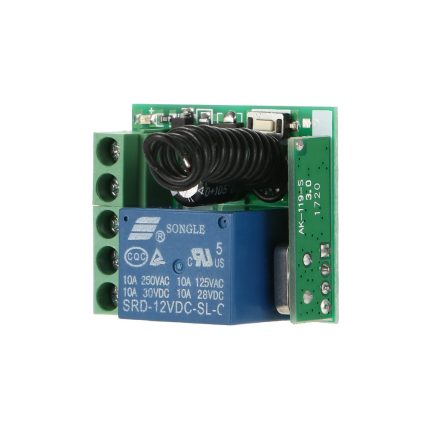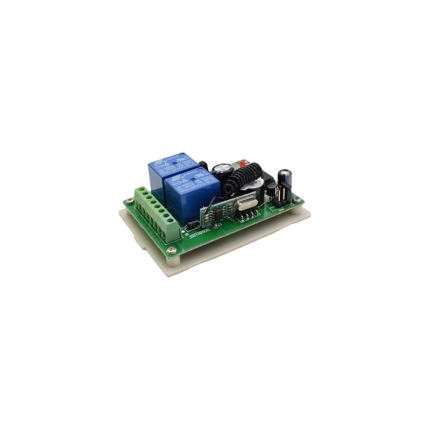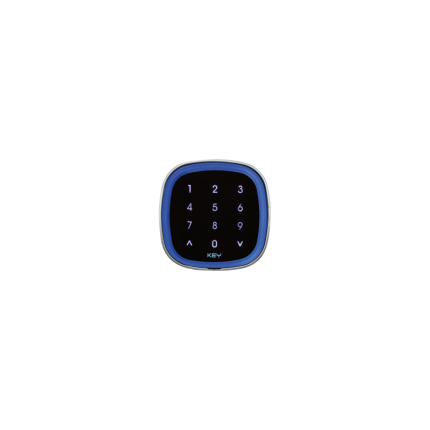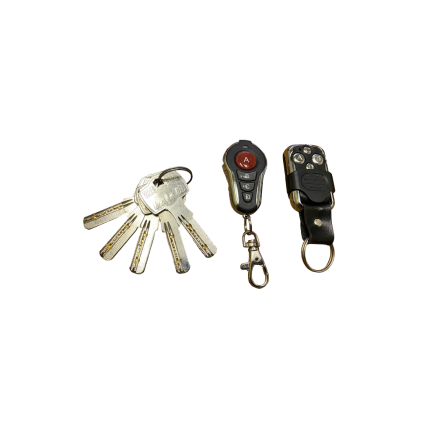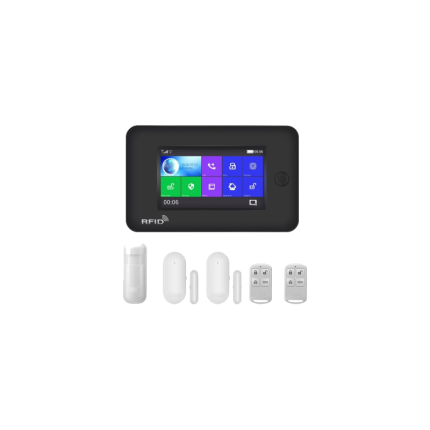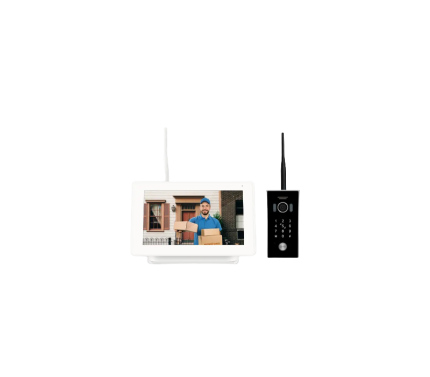remote
Gate Opener Remote Control 1400FT315/2-CH
Ship or pick up from our office.
Gate Opener Remote Control 1400FT315/2-CH
A high-range gate opener remote control 1400FT315/2-CH allows you to operate your gates from a greater distance than standard remotes, typically offering a range of several hundred feet or even up to a mile or more.
These remotes are often used in situations where the gate is located far from the entrance or when there are obstructions between the remote and the receiver.
Here's a more detailed explanation about Gate Opener Remote Control 1400FT315/2-CH:
What makes it high-range?
-
Stronger Transmitter:High-range remotes have a more powerful transmitter than standard remotes, allowing them to send a stronger signal over a longer distance.
-
Specialized Receiver:These remotes often work with a specialized receiver that is more sensitive and capable of picking up weaker signals.
-
Frequency:High-range remotes typically operate on a specific frequency (e.g., 433MHz or 315MHz) that is less prone to interference and allows for better transmission.
Benefits of high-range remotes like as the Gate Opener Remote Control 1400FT315/2-CH:
-
Increased Convenience:You can open your gate from a greater distance, which is particularly useful for large properties or when driving up to the gate.
-
Improved Security:High-range remotes can help prevent unauthorized access by allowing you to activate the gate from a safe distance.
-
Enhanced Flexibility:They can be used in a wider range of situations, such as when you need to open the gate for deliveries or visitors.
Factors affecting range:
-
Line of Sight:The range is usually maximized when there is a clear line of sight between the remote and the receiver.
-
Obstructions:Walls, trees, and other obstructions can reduce the range of the remote.
-
Weather Conditions:Extreme weather conditions like heavy rain or snow can also affect the range.
-
Antenna Placement:Proper placement of the antenna on the receiver can help improve the range.
Remote Control Radio Receiver
Ship or pick up from our office.
Remote Control Radio Receiver
- NC/NO Output
- Easy to program new remotes
- The remote control button is covered to prevent accidental pressing.
- This radio receiver can be added to almost all the gate operators such as Italian, Chinese, swing gate operators, sliding gate operators, and overhead garage doors.
- Compatible with 100 remotes.
- Small case and easy to install
- The wireless RF signals can pass through walls, floors, doors, or windows. You can use two or more units in the same place.
A gate opener's remote control radio receiver is a device that receives radio signals from a handheld remote control, triggering the gate opener's motor to open or close the gate.
Here's a more detailed explanation:
-
Receives Signals:The receiver picks up radio waves transmitted by the remote control.
-
Decodes Commands:It interprets the specific signal pattern to understand the desired action (e.g., open, close, stop).
-
Controls Devices:The receiver then sends signals to the gate opener's motor, causing it to move the gate accordingly.
-
Part of a System:It's a crucial component of the remote control system, working with the transmitter (remote) to enable wireless control of the gate.
-
Frequency:Gate opener receivers typically operate on frequencies like 433 MHz or 315 MHz.
-
Installation:The receiver is usually wired to the gate operator's control board and may require programming to associate it with specific remote controls.
Radio remote control receiver
Ship or pick up from our office.
Radio remote control receiver
One remote control is included (Compatible with Home-Link system) *DC 12-24 V *2 Channels *315 MHzA radio remote control receiver is an electronic device that receives signals from a remote control and triggers the gate's motor to open or close.
It acts as the "ear" for the gate opener, interpreting the radio signals sent by the remote. These receivers are crucial for the functionality and convenience of automated gate systems.
Here's a more detailed explanation:
Function:
- The receiver is designed to detect the specific radio frequency and code transmitted by the gate remote.
- Upon receiving the correct signal, it activates the gate's motor, causing the gate to move.
Wireless Keypad Access Control -Key Automation EGKTR1
Ship or pick up from our office.
Wireless Keypad Access Control -Key Automation EGKTR1
*Wireless*Rain Shield Cover Included
*Finger Touch *Back Light *Protection degree: IP 55The EGKTR1 is a wireless digital keypad manufactured by Key Automation, designed for access control, particularly for automatic gates and doors.
It utilizes capacitive touch technology and is compatible with Key Automation control units and receivers. The keypad allows for secure and convenient entry management using a user-defined code, eliminating the need for physical keys or remotes.
Here's a more detailed breakdown:
-
Wireless and Keyless Entry:The EGKTR1 enables keyless entry to properties by allowing users to enter a personalized code on the keypad to activate the gate or door.
-
Capacitive Touch Technology:This technology provides a responsive and durable touch surface, similar to a smartphone screen.
-
Compatibility:It's designed to work with Key Automation control units and receivers, making it a suitable addition to their access control systems.
-
Security Features:The EGKTR1 is a security device, providing controlled access to properties and can be programmed with multiple user codes.
-
Applications:It can be used for various applications, including commercial and residential buildings, educational institutions, and industrial facilities.
-
Installation and Programming:The keypad is designed for easy installation and programming, often with user-friendly instructions and procedures.
Keypad access control -Key Automation EGKTB1
PRODUCT SHEET PDF
While a specific image of the EGKTB1 is not available in the search results, the description aligns with the typical features and functionality of a keypad used for access control. You can likely find images of similar keypads by searching for "Keypad Access Control" or "Keypad Security System".
Keypad access control -Key Automation EGKTB1
*BUS decoder powered *Rain Shield Cover Included *Touch *Protection degree: IP 55 *BacklightTECHNICAL FEATURES
| Duty cycle percentage | % | 100% |
| Voltage | Vac | 10-24 |
| Voltage | Vdc | 12-34 |
| AC Voltage Frequency | Hz | 50/60 |
| Nominal power | W | 0,25 |
| Peak power | W | 1,5 |
| Appliance isolation class | III | |
| Degree of protection | IP | 55 |
| Dimensions (L - D - H) | mm | 79 - 23 - 79 |
| Item | kg | 0,25 |
| Minimum operating temperature | °C | -10 |
| Max operating temperature | °C | +55 |
The Keypad Key Automation EGKTB1 is a keypad used for access control.
It's a type of electronic keypad that likely integrates with a security system to allow entry based on a code or combination.
Keypads like the EGKTB1 typically replace traditional keys and locks, providing a more secure and convenient way to manage access to a building or specific areas within a building.
Here's a more detailed explanation:
-
Access Control:The primary function of the EGKTB1 is to control access to a secured area.
-
Keypad Functionality:It allows users to enter a pre-set code using the keypad's buttons. This code is then verified by the connected security system.
-
Integration:It's designed to connect with a security system or control unit, often using a Wiegand protocol, to manage access permissions.
-
Security:Keypads offer a more secure alternative to traditional keys because they can be reprogrammed with new codes, and they eliminate the need to physically distribute keys.
-
Convenience:Keypads offer a convenient way to manage access, especially in situations where there are many users or frequent changes in access needs.
Pedestrian gate electric lock with remote control
Ship or pick up from our office.
Pedestrian gate electric lock with remote control
* Two remote controls included *DC 12 V pedestrian gate electric lock with a remote control is a security system that allows you to lock and unlock a walk-through gate using an electrical mechanism, typically activated by a remote control. This provides convenience and enhanced security, as you don't need a physical key to open the gate. Here's a breakdown of what it entails: How it Works:- Electric Lock Mechanism: Instead of a traditional manual deadbolt or latch, an electric lock uses an electrical impulse to control a bolt or latch. This impulse can come from a control board connected to various access control devices.
- Remote Control Activation: A key component is the remote control, which sends a wireless signal (radio frequency) to a receiver connected to the lock's control system. When the signal is received and recognized, the lock is instructed to engage (lock) or disengage (unlock).
- Integration with Gate Systems: These locks are often integrated with automatic gate openers or access control systems. When the gate closes, the lock can automatically engage, and when a remote signal is given, it disengages to allow the gate to open.
- Power Source: Electric locks require a power source, typically low voltage (e.g., 12V DC). Many systems include a battery backup to ensure continued operation during power outages.
- Solenoid Locks: These use an electromagnet to extend or retract a bolt, securing or releasing the gate.
- Electromagnetic Locks (Mag Locks): These consist of an electromagnet mounted on the gate frame and a metal strike plate on the gate itself. When power is applied, the electromagnet creates a powerful magnetic force that holds the gate shut. Removing power releases the lock.
- Electric Strikes: These replace the standard strike plate on the gate frame. They contain a solenoid that, when activated, pivots or retracts to release the gate's latch. They are often combined with a traditional keyed doorknob or lever.
- Remote Operation: The primary benefit, allowing you to open or close the gate from a distance.
- Automatic Operation: Many models automatically lock when the gate closes, improving security.
- Fail-Safe vs. Fail-Secure:
- Fail-Secure: The lock remains locked when power is lost. This is common for high-security applications where you want the gate to stay secure even during a power outage.
- Fail-Safe: The lock unlocks when power is lost. This might be preferred for safety reasons, ensuring an exit path in an emergency.
- Holding Force: This indicates the strength of the lock in resisting forced entry, measured in pounds (lbs).
- Compatibility: Ensure the electric lock is compatible with your specific gate type (wood, metal, swing, etc.) and any existing or planned access control systems (keypads, intercoms, smart home systems).
- Manual Override: Many electric locks include a manual release key or mechanism for use in case of power failure or remote control malfunction.
- Durability and Weather Resistance: Given that they are outdoors, look for locks built with durable, weather-resistant materials.
- Integration with Other Access Control: Beyond remote controls, these locks can often be integrated with:
- Keypads (for code entry)
- Intercom systems (audio/video communication and remote release)
- Smartphone apps (for remote monitoring and control)
- Biometric readers (fingerprint, face scan)
Home Alarm System – WIFI SX1
Ship or pick up from our office.
Home Alarm System - WIFI SX1
Included: *Wireless/Wired Zones *WiFi network, support APP push/SMS/Voice, such as different alarm channels *Multi-language menu, Touch screen display *2 x ON/Off Remote control *2 x Wireless magnetic sensor *1 x Wireless PIR Infrared Sensor The "Home Alarm System - WIFI SX1" appears to refer to a specific type of DIY-friendly, wireless home security system that leverages both Wi-Fi and 4G connectivity for enhanced reliability. While specific manufacturers might produce variations, the general characteristics of an SX1 system include: Key Features and Functionality:- Wireless and DIY Installation: Designed for easy setup without complex wiring or professional installation, often using double-sided adhesive tape for sensors.
- Wi-Fi and 4G Connectivity: This is a core feature, allowing remote monitoring and control via a smartphone app (e.g., SmartHome Security app, Nexxt Home app, X-Sense Home Security app, or generic Tuya Smart/Smart Life app). The 4G acts as a backup in case of Wi-Fi outages, ensuring continuous protection.
- Battery Backup: A built-in lithium battery (often 3.7V/900mA, providing about 12 hours of backup) ensures the system remains operational during power failures.
- Expandability: These systems are typically expandable, allowing users to add numerous sensors (e.g., up to 50 or 99 sensors and 10 remote controls) to cover various areas of their home or office.
- Variety of Sensors: Common sensors include:
- Door/window contact sensors
- Motion detectors (often pet-immune)
- Smoke and carbon monoxide detectors
- Flood sensors
- Glass break sensors
- Loud Siren: An integrated siren (often around 110-120dB) sounds to alert occupants and deter intruders.
- Real-time Notifications: Users receive instant alerts to their smartphones via the app when an alarm is triggered, a sensor detects activity, or there's a low battery or power loss.
- Customization: The ability to name sensors and remote controls for easier identification.
- Smart Home Integration: Many SX1 systems are compatible with popular smart home platforms like Amazon Alexa, Google Home, and IFTTT, allowing for voice control and integration into broader home automation routines.
- Auto-dialing and SMS Alerts: The system can often be configured to automatically dial pre-programmed numbers and send SMS alerts in case of an alarm.
- Professional Monitoring (Optional): While often a DIY system, some providers or versions might offer optional professional monitoring services for 24/7 security team response.
- Affordability: Often seen as a cost-effective security solution, especially with no mandatory monthly fees (though professional monitoring may incur fees).
- Ease of Use: User-friendly mobile apps and straightforward installation.
- Flexibility: Easily expandable and adaptable to various home or office sizes and security needs.
- Peace of Mind: Home alarm system - WIFI SX1, provides continuous monitoring and alerts, even when away from home.
- Setup Challenges: Some users have reported initial setup difficulties due to unclear instructions or issues with sensor reliability.
- Sensor Reliability: Occasional reports of inconsistent sensor performance or false alarms.
- Wi-Fi Dependency: While 4G provides backup, a stable 2.4 GHz Wi-Fi network is typically required for initial setup and full functionality.
- App Performance: While generally praised, some apps can have occasional freezing or delayed alert issues.

